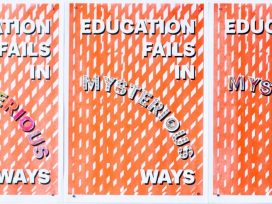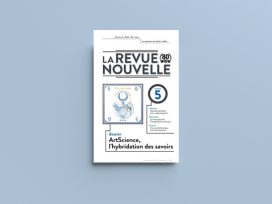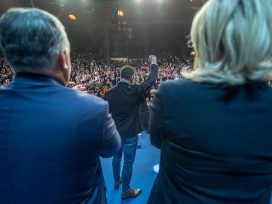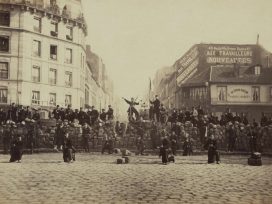As mayor of Bogotá, Antanas Mockus employed artistic strategies in politics calling them “sub-art”: an appropriation of procedures specific to art, but applied for reaching a specific goal in society. Mockus, the son of a sculptor, is a philosopher, mathematician, and former university dean who initiated a non-violent, performative politics of images and gestures in the mid-1990s in a Colombian aura of hostility, bloodshed and narco-traffic.

Antanas Mockus. Photo: Claudia Rubio. Source:Flickr
Together with his team he introduced a programme of citizen culture called Cultura ciudadana, which fundamentally shifted the paradigm for making and experiencing politics in Latin America towards a civic self-education method based on play and staged situations. The goal of Cultura ciudadana was to create what Mockus calls active citizenship. Instead of just living in the same city, citizens should perceive it as a common project based on mutual interdependence and emergence that all of them take part in.
As a politician and mayor, Mockus was someone who treated art seriously and tried to transport it into the realm of politics. His mayoral term was later called the “Bogotá change.” He served two terms as a mayor, during the first term (1995-1997) he was very imaginative, acting with humour and cautious, in his second term (2001-2003) he seemed more solemn, and finally in the presidential campaign in 2010, he became an orthodox democrat, refusing to see himself as a possible governor, forging the idea that power is in the hands of all the people. First as a mayor and later as a presidential candidate he employed an art-driven imaginary to suspend “business as usual” in order to destabilize rational discourse, disarm hate speech and bureaucratic rule, and to bring about an understanding of emergence, multitude and community.
Very often Mockus referred to contemporary art as a reservoir of his ideas. Why exactly did he need art for? He smuggled an art agenda into politics, seeking inspiring content not in church but in an exhibition, often saying: “When I am trapped, I try to do what an artist would do.” He claimed that for him as a politician, art was helpful in opening up what he would call “new ways of doing politics.” Elected mayor of Bogotá in 1993, he started to implement a number of “artistically driven” actions. Being a long-term teacher, he believed that the community has to understand and pursue its common interests, realize its ability to lose and gain something. Together with his team he started to introduce games and symbols, which would visualize the common social goals.
One of the first actions dealt with violence and murders. It was held at the communal cemetery, and focused on the very significant drop in the city’s homicide rate from one year to the next. A powerful campaign was launched saying that life is sacred, and that taking a life to get a phone or a car is worthless. The programme was called “Life is Sacred” (La vida es sacrada) and led to a near fifty-per-cent reduction in the murder rate, a figure that no statistics would have found realistic or possible. The intention behind the cemetery action was to visualize how many lives were saved the previous year. Taking advantage of the fact that part of the cemetery was empty on the holiday of the Day of the Dead, Mockus invited five hundred people – equivalent to the number of survivors – and asked them step inside the empty crypts. When they jumped out of the tombs, it served as evidence of all the lives saved. The slogan that came out of this was “Let’s keep those graves empty”.
Another performative action was connected with water shortages. Bogotá needed to drastically save on water. Mockus decided to appear on TV in a short commercial where he was half naked taking a shower and turning off the water as he soaped, asking Colombian citizens to do the same. In just two months people started to use less water, and water usage dropped forty per cent lower than before the shortages. This and other actions can be seen as part of what he called “a super-citizenship”. In fact, at the beginning of his career, he would often appear in a Superman costume.
Mockus also borrowed from art and artists the concept of lobbying for lost causes and dispensation from observing norms. Artists often claim not to look to their interests but to the totality of society and its wellbeing. He pushed artistic questioning of the status quo in the direction of social experiment and a new type of political practice: vulnerable, naive but constructive. Many actions that Mockus initiated played with the Colombians’ Christian feeling of guilt, what he otherwise called self-control and mutual support. The emotions became a tool in the city agenda to increase the number of law-abiding citizens and their capacity and will to influence each other through law-abiding behaviour, and fostering communication and the potential for expression.
One of the most meaningful examples of regulating citizen behaviour outside of the law systems of sanctions and gratification was the establishing of a network of libraries. Together with historian Jorge Orleando Melo, the town hall founded a library programme in violent districts of Bogotá. In the midst of crime and poverty, the new large libraries became zones of safety and social reliance. When people wanted to take out a book, librarians handed over the volumes with one remark: “We trust you to return it” – with no registration, no bureaucracy, no deposits. That was Mockus’s way of visualizing the mechanism of how trust – as one of the strongest social binds – works. He believed that if you trust someone, the fear of losing trust will regulate their behaviour. As a result, less books were stolen than in the regular libraries.
Probably the most threatening issue in Bogotá was the number of firearms, especially in the slums and poor neighbourhoods. To fight the problem Mockus used an operation explicitly belonging to the arts toolbox. Namely, in Bogotá it was legal to carry weapons in all public spaces as a means of self-defence. The rule had only one exception. The only circumstance where guns were illegal was at public spectacles. Mockus then applied a Marcel Duchamp-like gesture and declared everything that happens in the streets, parks and establishments a public spectacle, a city as an artwork and as a ready-made. With this simple objet trouvé twist, weapons were made unwelcome on the streets.
Complementarily the town hall created yet another playful staged situation – a programme offering to exchange guns for gifts, and toy guns for different kinds of toys. Kids would come and exchange them every now and then. And surprisingly, the programme, which at the beginning was more of a symbolic act, became a real strategy as a larger number of citizens accepted it and became involved in it. Violence, the worst of plagues of Latin America, was dismantled by joy, and kids became the primary addressers of such actions: they were addressed to advise parents to give up on arms.
Later in his mayoral term, getting deeper into the analysis of the way violence works, Mockus noticed a strong symbolical component and drew parallels between art and terrorism. This stemmed from his observations that perpetrators often aim at stirring emotions in order to produce a meaning, as artists do. On the other hand, what he learned from art is that a real action can be completely substituted by a symbolical gesture. In order to sublimate the violence into a symbolical gesture or a metaphor, Mockus invented “vaccination against violence.” It was a workshop situation in which people were asked to draw the faces of the people that had hurt them on balloons, which they then popped and destroyed.
There is, however, a limit to the reality that the symbols are always confronted with: if somebody had shot his bullet-proof jacket, in which he cut a heart inside, the symbolism would be over, it would crash with the real and Mockus would simply die.
Finally, maybe the most significant example of appropriating art and applying it directly in a concrete, social situation was when street mimes, standing next to policemen, controlled traffic. The classical mime in Bogotá is one who follows you and walks in the direction of the passer-by. Mockus picked up on their potential of carrying out criticism through imitation and invited twenty professional mimes to help control streetlight traffic. The programme was accepted by the citizens to such an extent that an additional 400 people went through professional art training and became mimes. When the idea was initially announced, journalists asked whether the mimes would be able to hand out fines, and if not – how could that work. And that was precisely Mockus’s challenge: how can one be educated without the fear of punishment? When drivers parked their cars on sidewalks not respecting the space for pedestrians, the mimes would reproach them by showing yellow or red cards like in a soccer game. Once they felt ashamed, the drivers would respect others. The red and yellow cards soon became a tool commonly used by people to react if somebody did something wrong.
Mockus seemed to have understood what Chantal Mouffe describes as the central role emotions and passions have in the creation of collective political identities. He believed that instead of putting interests and reason before sentiments and passions, the political strategy of the Left today should be incorporating precisely those intangible, affective factors.
In situations where the usual way of doing politics, together with law as regulatory apparatus fails, other incentives needs to be sought. It is exactly here that the assets specific to art, such as the above described lucidity, performativity and symbolical surplus production could be mobilized.
Some saw his politics as leftist populism, jocular leadership, a good-willed naive politician or self-proclaimed moral authority. But his mode of curating a city was to produce what art is often intended to produce: a re-contextualization and understanding of both individual and common agendas, making citizens see the system they are a part of, and taking responsibility.
Moreover, the strategy he used to achieve this is in itself specific to art. Contemporary art engages itself not necessarily only in creating art objects, but in staging situations in which interaction among citizens and interaction on political issues can occur, be understood and analysed. Coming from pedagogy, he used art and the politics of images and representation for enforcing the distribution of knowledge. And knowledge combined with humour and joviality gave people a possibility and openness to bring about and accept change.
In many interviews and also as a participant of the 7th Berlin Biennale Mockus said: “There are two general approaches: producing art for art, which was often the case in late capitalism; or seeing it as a privileged language for changing the society. I believe that you can retain the elitist concept of art and at the same time be involved in a social experiment. I’d rather retain the ambitions of art and make them public.” He also worked towards privileging pedagogy and knowledge distribution, giving them the symbolic value of art: “It’s strange that the society seems to value art a lot more than pedagogy. If you look at all the effort made in the academic field, you’ll soon notice that pedagogy is an amorphous, underestimated zone, while art sits on the other extreme of the spectrum. Both disciplines share the same pleasure of understanding, teaching, and developing new meanings and possibilities. Being notable, truthful, and lucid in pedagogy, one is still valued less than as an artist.”
After ending his second term as mayor, Mockus continued his political practice and in 2010 decided to run for president only four months before the election. At a certain point, his statistics were rising and he had a very good chance. But then he became very unorthodox in his symbolic methods, almost suicidal, stressing that in democracy we don’t need the figure of a leader and visualizing its equal and holistic character. On a TV talk show during the presidential campaign he was asked to take a seat in a large wooden chair. He refused, thus leaving “an empty throne,” manifesting his wish that the leader’s chair be vacant, and showing that executive power in fact lies in our hands if only we want it to. He also publicly asked his opponent to run a campaign for him: “I proposed to him: I make a campaign for you, you make a campaign for me and in some way, everybody wins.” Mockus campaign posters depicted both candidates to illustrate the political spectrum: “My best friend said: Antanas, it’s too Machiavellic. I thought the contrary. It was a communication strategy. People had to know in an equilibrated way about the proposals.” But society was not ready: such political behaviour made him too weak and too confused, along with the diagnosis of Parkinson’s disease.
Mockus is in fact in a long chain of political performers in Colombian politics. Starting from the leader of the Liberal Party, Jorge Eliécer Gaitán Ayala, who was murdered in 1948. He organized a March of Silence bringing together a lot of people who marched the streets of Bogotá in silence. When they convened in the city’s largest square, his political enemies expected him to make a big speech or a statement like: “Let’s go and kill the oligarchs of this country”. But he didn’t say anything and people returned to their homes in silence.
In the 1970s, a guerrilla group called 19th of April Movement, or M-19, also used symbols as weapons. One of their first political performances was stealing Bolívar’s sword from the National Museum, and delivering a justification speech that sounded like an avant-garde manifesto. They claimed that the objects in museums were dead and that the stolen sword had to be restored to the public realm and to become an active symbol of the ongoing political fight in Latin America. Lucas Ospina, a Columbian artist and political commentator, claims that Mockus left behind a bit of nostalgia for his politics, but his political practice is unfortunately losing impact. His personality was important, along with his original Lithuanian name and his immigrant origin. He’s a gringo, a foreigner who has and always will live as a Colombian. One could compare him to an artist who is a stranger coming from outer space to transform the lives of the natives, a person who’s set in a context but does not completely belong. It is important to understand the phenomenon of Mockus in the context of a country like Colombia, which remained off limits for immigrants for many years – during WWII and after.
Today Mockus is creating the “Coprovisionarios method”, a policy methodology based on his actions. He uses it as a toolbox to consult other cities in South America and even Europe about addressing their specific problems. One of the cities he consulted was Stuttgart concerning the Stuttgart 21 debate – a railway and urban development project evoking a lot of protests. Probably what the European city councils could learn from the “Bogotá change” was the understanding of politics, which includes art beyond its decorative and capitalist function and taken out of its autonomous safety zone. For Mockus, artists were never puzzles of a Leistungsschau, a decoration, a tourist attraction, or good company at EU or even Vatican saloons. He saw artists as partners in the think-and-do tanks, in the process of organizing society, in turning the game of personal interests into a passionate political action.







